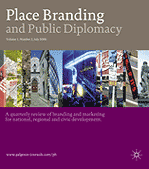The International Branding of the Nordic Region is the focus of this research insight and case study, based on a recent article published in the academic journal ‘Place Branding and Public Diplomacy’. In the article, Johannes Magnus presents the intriguing case of the Nordic region’s initiative to brand itself internationally, requiring collaboration among many different stakeholders and concerted action across country borders.
Learn about:
- How five countries and three autonomous territories are collaborating for joint region branding;
- The approach to strategically brand the Nordic region;
- Whether the branding strategy for the Nordic region can be considered a success;
- What it takes for region branding initiatives to be successful.
Johannes, what motivated you to write this article for the journal Place Branding and Public Diplomacy?
Back in 2013 the Nordic Ministers for Cooperation had commissioned the Secretariat to the Council of Ministers to explore the idea of setting up a joint Nordic strategy for international branding of the Nordic region. Bodil Tingsby (former Head of Communication in the Nordic Council of Ministers), Jesper Schou-Knudsen (former advisor at the Nordic Council of Ministers) and myself were appointed to create a pilot study, which later led to the first-ever strategy for branding the Nordic region internationally.
Which are the key insights from this project?
The work with the pilot study and the strategy was extremely interesting, due to the projects uniqueness of being the first attempt to strategically brand the whole Nordic region: five countries and three autonomous territories. The work gave us important insights how to brand the region.
First of all, it was important to identify and coordinate the Nordic brand architecture, and to outline how all the sub-brands, such as ‘New Nordic Food,’ ‘Nordic Noir,’ and ‘the Nordic Model’ are interrelated. While similar brand architectures are primarily used in the private sector, this approach is also applicable to the challenges in a diverse region of different national narratives.
Establishing a strong brand architecture allowed the Nordic countries to minimize intra-brand competition and encourage involvement of all relevant stakeholders in the brand-building process.
Secondly, using the term ‘The Nordic Region’ as a unified concept enabled each country or player to refer to characteristics that do not apply specifically and individually to Sweden, Denmark, Norway, Finland, Iceland, Åland, the Faroe Islands or Greenland. For example, the brand could emphasize being part of a strong region with a population of 25 million and a large and diverse range of industries and culture—not to mention a varied and fascinating natural environment—and all the opportunities that arise as a result thereof.
Thirdly, the strategy is overarching, and includes all political sectors and industries.
The Nordic region is a complex mixture of elements, many of them intangible: ‘soft’ aspects such as feelings, mental associations, perceptions and emotions. It is the intangible aspects of the Nordic brand that make it so valuable and desirable, because the brand is emotional by nature.
Also, what binds the Nordic countries together is what generates sufficient strength to attract the interest of the outside world. After years of close and successful collaboration, we in the Nordic region take our common areas of strength for granted. Nevertheless, it is important to express the common strengths we feel we have in relation to the outside world. The region branding strategy establishes what we are and how we want to be perceived among audiences outside of the Nordic region.
Has your view on the Nordic region as brand changed after your work there?
I asked myself several times when developing the Nordic region brand strategy: is it really possible to bundle together all these rich and diverse cultures under a common brand identity? After finalizing the strategy, I would argument that the answer is no.
Nothing and no one, neither a country nor a region, really controls its image, especially in today’s transparent, fast-moving and increasingly digital communication landscape. The image is earned. For long-term and sustainable relations with other countries, the offer must be genuine.
Branding communication requires credibility and authenticity. You have to be what you claim to be and want to be. Challenges arise if there is no common identity in the area.
This is why the philosophy of a joint Nordic branding platform must not limit in any way the individual countries’ activities to brand their own strengths. Each Nordic country has its own unique brand, and part of the strength in the region may stem from the fact that the Nordic countries have a long history of healthy competition with each other.
Despite this, over the years the relationship between the Nordic countries has generated added value. If one country does something, all countries gain from it.
The purpose of a joint regional branding platform is to supplement and strengthen each country’s individual brand by helping to create clearer and more consistent branding of our common region.
How has the branding of the Nordic region changed since your involvement?
Since I no longer work with the projects, I only read about it and talk to my former colleagues. But I am very glad to hear that the Nordic Council of Ministers has picked a best-in-class creative team to help them leverage the potential of the brand of the Nordic countries. It is exciting to hear that the famous Danish architect Bjarke Ingels’ firm (BIG) has been appointed to help develop further the brand identity in projects around the world. I applaud the ambition and work that is being done by all stakeholders.
Would you consider the Nordic region’s place branding initiatives a success?
The branding initiative as a whole is intended to be evaluated at the end of 2018. I believe we need to wait even longer to judge the outcome of the strategy. It is rather difficult to measure the success of nation branding or regional branding because of the complexity of influencing elements and intangible feelings people have to countries. But the countries should, of course, evaluate selected branding projects in the years to come.
I truly believe that the positive international focus on the Nordic region and Nordic countries will be utilized and strengthened by joint branding activities, not least in markets where awareness of the region is greater than awareness of each individual country. Coordinated branding activities will also strengthen existing relationships in the more immediate geographical vicinity.
Thank you, Johannes.
Read or download the article here
About Place Branding and Public Diplomacy
 Place Branding and Public Diplomacy is the first and only journal to concentrate on the practice of applying brand strategy and other marketing techniques and disciplines to the economic, social, political and cultural development of cities, regions and countries.
Place Branding and Public Diplomacy is the first and only journal to concentrate on the practice of applying brand strategy and other marketing techniques and disciplines to the economic, social, political and cultural development of cities, regions and countries.
The Place Brand Observer has teamed up with the journal’s publisher, Palgrave, to share with you key insights and findings, in alignment with our mission to make academic writing more accessible to practitioners (more about our mission here).
Learn more about the journal here or read the stories of the journal’s editors, Robert Govers and Nick Cull.
 About Johannes Magnus
About Johannes Magnus
Johannes Magnus (b. 1985) is Norwegian and has been working as an advisor and international brand strategist at the Nordic Council of Ministers secretariat in Copenhagen, Denmark. Today Magnus manages international relations at the Bergen Chamber of Commerce in Norway. He holds a master degree in Media and Communication Science from the University of Copenhagen. In addition, he has studied at University of California, Berkeley, Copenhagen Business School and University of Bergen.
Connect with Johannes Magnus on LinkedIn.
Featured image: Sculpture of Britt Smelvær. Foto: Oddleiv Apneseth/norden.org
Enjoyed this research summary and case study by Johannes Magnus on the international branding strategy of Europe’s Nordic region? Share and spread the word!


